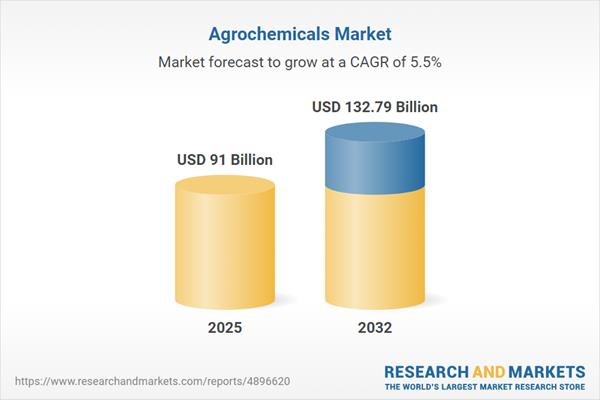Speak directly to the analyst to clarify any post sales queries you may have.
Senior decision-makers in the agrochemicals market are confronting significant transformation as sustainability pressures, compliance requirements, and operational complexities become increasingly interlinked. As the sector evolves rapidly, leadership teams must proactively adopt new strategies and technologies to maintain market position and unlock lasting value.
Market Snapshot: Agrochemicals Market Growth & Trends
In 2024, the agrochemicals market reached a value of USD 86.26 billion, with projections indicating further growth to USD 91.00 billion in 2025 and USD 132.79 billion by 2032, reflecting a 5.54% compound annual growth rate.
Market expansion is supported by the wider adoption of advanced crop protection technologies, shifts toward integrated pest management, and heightened regulatory oversight. The combination of robust product development and digital infrastructure is enabling organizations to align with compliance and sustainability requirements. Stakeholders are compelled to refine operational practices and invest in agility, ensuring alignment with evolving industry expectations and ongoing regulatory changes.Scope & Segmentation of the Agrochemicals Market
This analysis details the multi-faceted structure of the agrochemicals market, empowering executives to optimize investments and harness technology for sustainable growth. Strategic segmentation streamlines planning, resource deployment, and risk management in the face of shifting market and regulatory dynamics.
- Product Type: Comprehensive focus on fungicides, including dithiocarbamates and triazoles, herbicides specifically designed for distinct crop demands, and primary insecticide groups—carbamates, neonicotinoids, organophosphates, pyrethroids, and rodenticides—enables targeted crop protection strategies.
- Nature: Increased adoption of biopesticides—covering microbial, biochemical, and plant-based agents—alongside established synthetic options offers manufacturers a spectrum of choices to address compliance and enhances research and development flexibility.
- Crop Type: Solutions address vital crop groups such as cereals, grains, oilseeds, pulses, fruits, and vegetables, supporting varying regional food security objectives and responding to evolving consumption trends.
- Formulation: Product forms, including powders, granules, concentrates, emulsifiable liquids, and suspensions, bolster operational adaptability, streamline deployment, and offer robust safety profiles for diverse global operations.
- Regions Covered: The Americas (including key markets like the U.S., Mexico, Brazil, Argentina), EMEA, and Asia-Pacific (notably China, India, and Southeast Asia) experience unique regulatory climates and technology uptake rates, influencing regional business models and competitive approaches.
- Key Companies: Global leaders such as Bayer AG, Corteva Inc., Syngenta AG, BASF SE, and FMC Corporation contribute to sector innovation, performance standardization, and pioneering research, driving the market’s forward momentum.
Key Takeaways for Senior Decision-Makers
- Growth in biological product adoption and advancements in digital platforms are facilitating sustainability transformations, boosting compliance efficiency, and improving overall supply chain transparency.
- The evolution of sourcing and distribution models is steering the market toward sustainable input selection and fostering the development of robust, resilient logistical infrastructure.
- Frequent portfolio evaluation and flexible planning processes have become central to maintaining operational resilience, particularly as the market diversifies across geographies and supply chains.
- Collaboration enabled by digitization is enhancing integration between corporate structures and regional suppliers, supporting fast, coordinated market responses.
- Linking supply chain, research, and regulatory functions ensures swift adaptation to policy adjustments and positions organizations to meet rising stakeholder expectations.
Tariff Impact: Supply Chain and Innovation Dynamics
Recent changes in tariff policy are compelling organizations to reevaluate sourcing strategies and manufacturing locations within the agrochemicals market. Enhanced cooperation between procurement and R&D teams is accelerating the shift toward alternative active ingredients and domestic production, which bolsters compliance and mitigates exposure to policy-driven risk, giving companies the flexibility to adjust as needed.
Methodology & Data Sources
This report integrates expertise from agronomic science, regulatory review, and supply chain management. All findings are sourced from peer-reviewed studies, recognized industry standards, and current legislative materials, ensuring the delivery of actionable intelligence for executive leadership.
Why This Report Matters
- Facilitates the integration of compliance, sourcing, and research strategies in both digital and traditional settings, addressing ongoing sector changes efficiently.
- Prepares executives to recognize new challenges, manage complex international and local value chains, and achieve optimal market positioning.
- Improves investment outcomes and strengthens industry partnerships amid regulatory, operational, and technology-driven transformation.
Conclusion
This report enables senior leaders to seize unfolding market opportunities while supporting operational agility and advancing sustainability as the agrochemicals sector continues to transform.
Additional Product Information:
- Purchase of this report includes 1 year online access with quarterly updates.
- This report can be updated on request. Please contact our Customer Experience team using the Ask a Question widget on our website.
Table of Contents
3. Executive Summary
4. Market Overview
7. Cumulative Impact of Artificial Intelligence 2025
Companies Mentioned
The companies profiled in this Agrochemicals market report include:- Bayer AG
- Corteva, Inc.
- Syngenta AG
- BASF SE
- FMC Corporation
- UPL Limited
- ADAMA Ltd.
- Sumitomo Chemical Co., Ltd.
- Nufarm Limited
- Isagro S.p.A.
Table Information
| Report Attribute | Details |
|---|---|
| No. of Pages | 195 |
| Published | November 2025 |
| Forecast Period | 2025 - 2032 |
| Estimated Market Value ( USD | $ 91 Billion |
| Forecasted Market Value ( USD | $ 132.79 Billion |
| Compound Annual Growth Rate | 5.5% |
| Regions Covered | Global |
| No. of Companies Mentioned | 11 |









